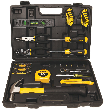Sinks seem to have a nasty habit of leaking when you don't want it to. While there are numerous possible causes for any leak in the kitchen, one of the most common is that of faulty caulking. It should be on any homeowners' list of annual home improvement projects to check the caulking around the joints, seams or pipes of any plumbing fixture in the home. Many people would be surprised to find out that this is one of the easiest home improvement projects that a homeowner could do.
Prior to starting your home plumbing venture, you are going to need to gather the materials and tools that are necessary to completing your project. There are just a few materials that are needed, the necessary tools are a multi-purpose tool (or a knife and some pliers), damp cloths or rags, and a caulking gun. The materials that are going to be needed are simple, all that you need to get is a tube or two of caulking that can be obtained at any home improvement department of any department, or hardware store.
The first step to re-caulking your sink would be to remove the old caulking. Removing the old caulking is simple, if maybe a little time consuming. Begin by using the knife, or knife attachment of the multi-tool to slice into the caulking. Try pull up the caulking by hand, but feel free to use the pliers attached to the multi-tool, or other pliers if you have are having any problems removing the caulking. When you have removed as much caulking as possible, take the damp cloth and use it to scrub off the remaining caulking. This both cleans off the area, as well as prepares it for the next step.
Next, you need to take the caulking gun and caulk and administer the substance to the area that you just cleaned off. A caulking gun is the best way of applying the caulk in a continuous and steady stream, ensuring that it is smooth and even, you can do it without if you don't have one, but it is strongly suggested that you use one if you can get one. Finally, use one of the damp cloths that you have waiting to wipe up any mess you may have, so that there is a professional appearance to your work. This also ensures that no mold or mildew grows in any cracks or seams you may have inadvertently left.
One last word of advice, once you have completed this project, you really want to let the caulking material dry. Before exposing the material to water, it needs to be dried out, or you are going to be redoing all of your hard work.

Find the Right Tool Right Away Finally, a homeowner's set that includes all the tools needed to complete basic DIY projects at an affordable price! The tools are stored in a molded case for security and portability. Check out Stanley 65-Piece Homeowner's Tool Kit today!
Considering that acrylic sinks are one of the more inexpensive types of sinks currently on the market, it only stands to ...
Discover MoreOne of the most important elements to any successful kitchen is the sink, and sadly one of the most overlooked. Many ...
Discover MoreOver time the aerators that are used in most faucets will become clogged with dirt, lime, or simply stop working for some ...
Discover MoreThere are currently no comments for this tip. (Be the first to leave your comment—just use the simple form above!)
Copyright © 2026 Sharon Parq Associates, Inc.
Comments